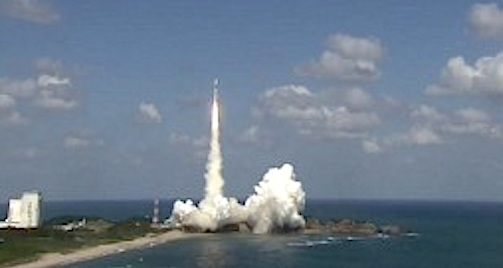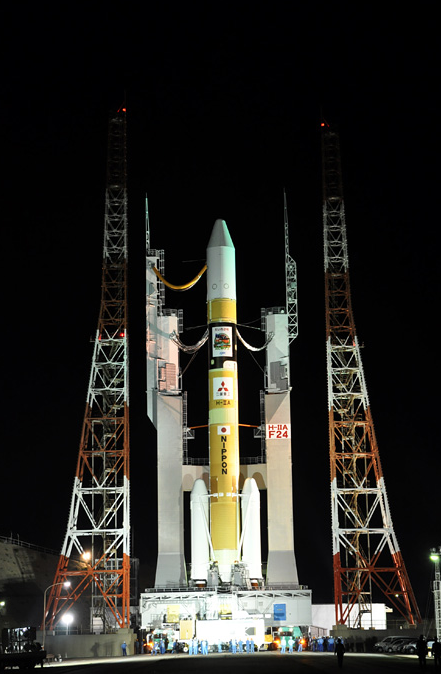
Japan launched its third mission of the year on Tuesday by lofting the Himawari 8 weather satellite atop an H-IIA carrier rocket. Liftoff from pad 1 of the Yoshinobu Launch Complex at the picturesque Tanegashima Space Centre occurred on schedule at 14:16 local time (05:16 UTC).
[SatNews] A huge task is not managed single-handedly, especially true when dealing with launching an enormous vehicle skyward fighting gravity every inch of the way.
Moog Inc. (NYSE: MOG.A and MOG.B) Space and Defense Group provided critical hardware to the Himawari-8 weather satellite, manufactured by Mitsubishi Electric Corporation (MELCO). The launch took place today from Tanegashima Space Center, Japan atop a Mitsubishi Heavy Industries (MHI) H-IIA Heavy-Lift Rocket Vehicle No. 25 (H-IIA F25) with the Geostationary Meteorological Satellite "Himawari-8" onboard at 2:16:00 p.m. on October 7, 2014 (Japan Standard Time, JST) from the Tanegashima Space Center. At the time of the launch, the weather was fine, a wind speed was 8.5 meters/second from the northeast and the temperature was 24.6 degrees Celsius.
The launch vehicle flew as planned, and, at about 27 minutes and 57 seconds after liftoff, the separation of the Himawari-8 was confirmed.
The MHI H-IIA rocket includes thrust vector control servovalves built in Moog’s Hiratsuka, Japan facility. This facility also provides roll control thruster valves for the Epsilon rocket that is based on solid rocket technology found on the H-IIA.
Moog latch valves control the flow of propellant in the propulsion system. Twelve bipropellant Moog Reaction Control System (RCS) Engines equipped with Moog thruster valves provide attitude control and station-keeping in orbit. The Moog Solar Array Drive Assembly (SADA) and Solar Array Drive Electronics (SADE) are critical in positioning the satellite’s solar panel towards the Sun.

Mitsubishi's H-IIA Heavy-Lift Rocket Vehicle
This launch is the continuation of the Himawari line of weather satellites operated by the Japan Meteorological Agency (JMA). Himawari means ‘sunflower’ in Japanese. Moog hardware was used on the successful Himawari-7 spacecraft also built by MELCO.
Himawari-8 will be placed in geosynchronous orbit capturing Earth images over East Asia and Western Pacific regions, contributing to disaster prevention of the area. Himawari-8/9 carry Advanced Himawari Imager (AHI) units comparable to the Advanced Baseline Imager (ABI) on board America’s GOES-R satellite to enable enhanced nowcasting, Numerical Weather Prediction (NWP) and climate/environment monitoring. The satellite will provide further demonstration of the DS2000 platform's well-established high reliability for in-orbit performance. The sister satellite Himawari-9 is planned to launch in 2016.
Moog Inc. is a worldwide designer, manufacturer, and integrator of precision control components and systems. Moog’s high-performance systems control military and commercial aircraft, satellites and space vehicles, launch vehicles, missiles, automated industrial machinery, wind energy, marine and medical equipment. Additional information about the company can be found at www.moog.com. Additional information about Moog’s Space Sector can be found at www.moog.com/space.

